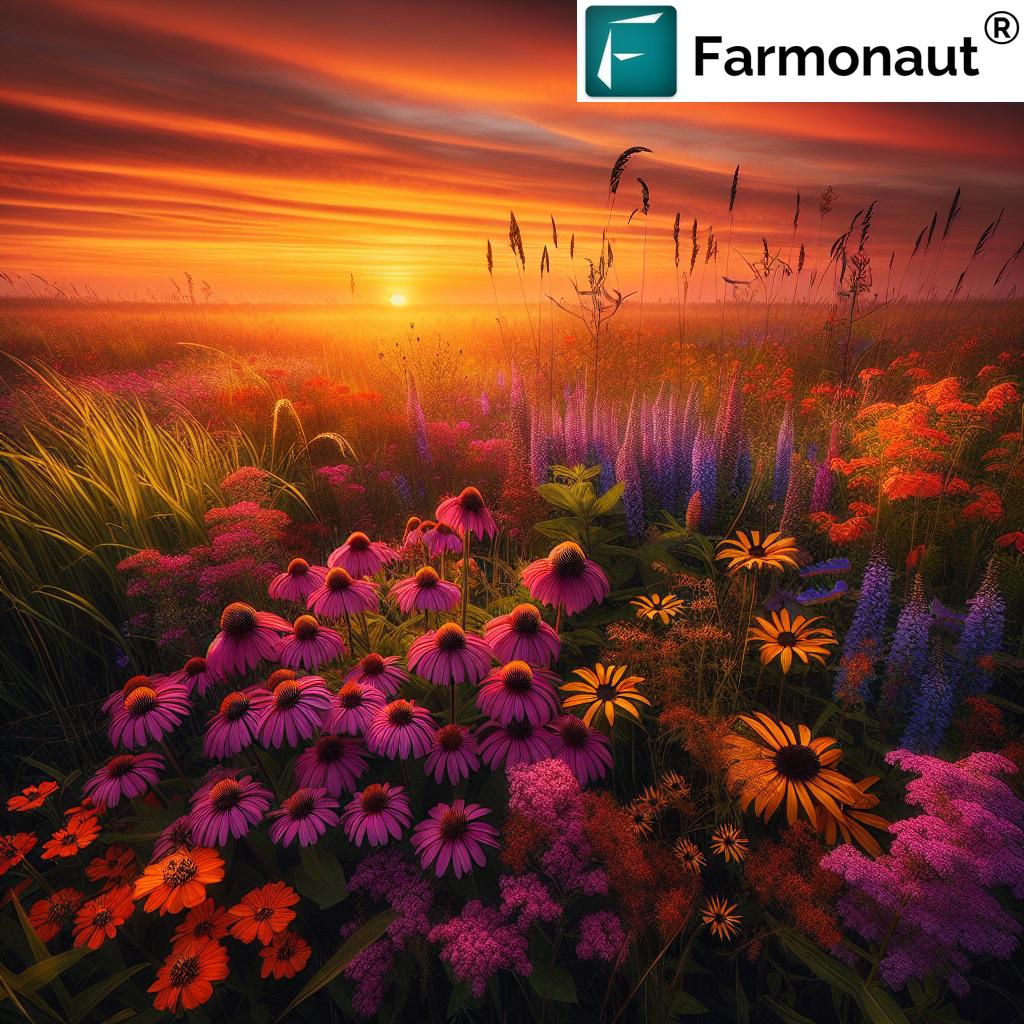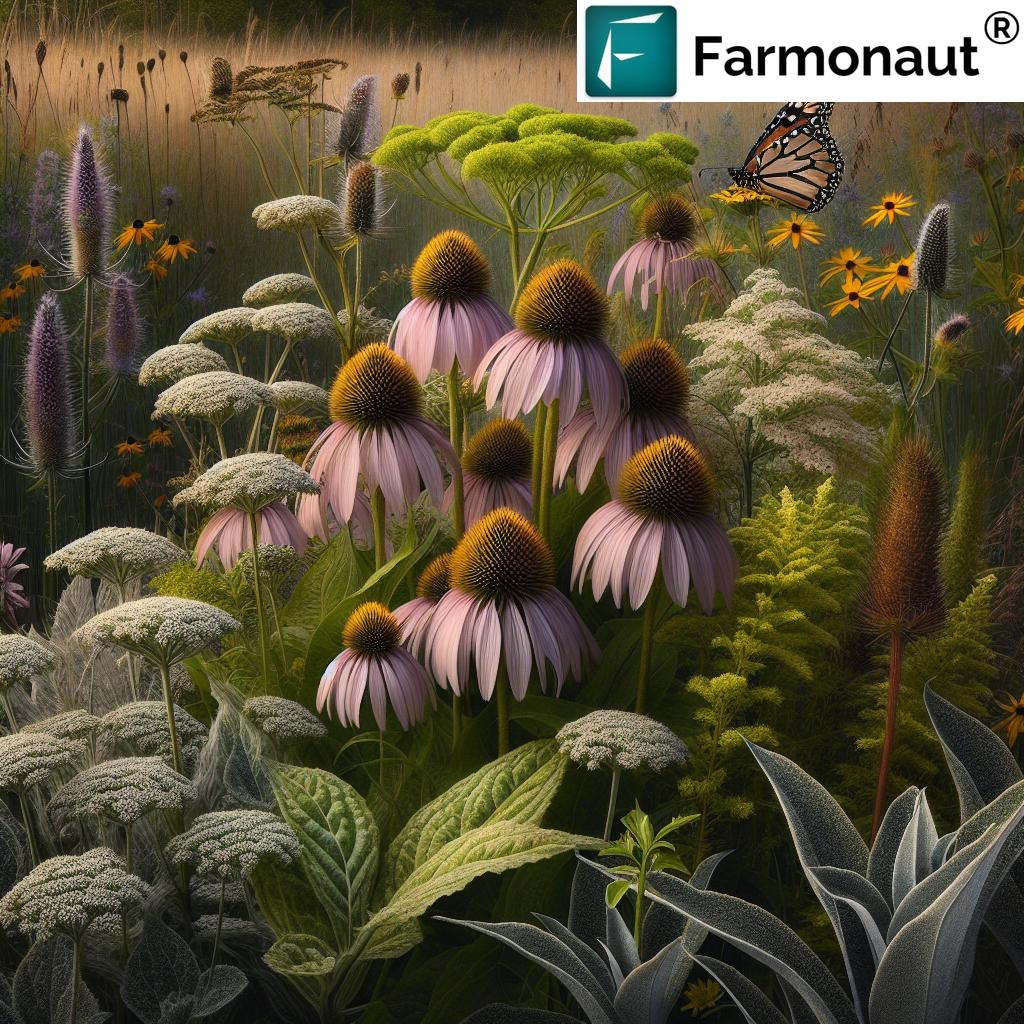Discover Illinois’ Prairie Wildflowers: A Comprehensive Guide to Native Plants and Biodiversity Conservation

“Illinois prairies host over 300 native wildflower species, including iconic plants like purple coneflower and black-eyed Susan.”
Welcome to our comprehensive guide on Illinois’ prairie wildflowers and native plants! In this extensive exploration, we’ll delve into the vibrant world of prairie flora, examining the unique plant communities that populate the state’s diverse ecological landscapes. From the rich Black Soil Prairie to the rugged Hill Prairie, we’ll uncover the beauty and significance of these natural treasures.
As we embark on this journey through Illinois’ prairies, we’ll focus on iconic species such as the purple coneflower, butterfly milkweed, and black-eyed Susan. These plants not only paint our landscapes with stunning colors but also play crucial roles in sustaining local wildlife and supporting pollination. Our guide serves as an invaluable resource for nature enthusiasts, conservationists, and anyone interested in the wonders of prairie ecosystems.
Understanding Illinois Prairie Ecosystems
Before we dive into the specific wildflowers that grace Illinois prairies, it’s essential to understand the unique characteristics of these ecosystems. Prairies are grassland biomes characterized by their vast expanses of grasses, forbs, and wildflowers. In Illinois, prairies once covered about 60% of the state’s landscape, making it one of the most significant prairie states in North America.
- Black Soil Prairie: This type of prairie is found in central and northern Illinois, known for its deep, fertile soil rich in organic matter.
- Hill Prairie: Located on steep, well-drained slopes, hill prairies support unique plant communities adapted to drier conditions.
- Sand Prairie: These prairies develop on sandy soils, often along major rivers, and host specialized plant species adapted to drought conditions.
Each of these prairie types supports a diverse array of wildflowers, contributing to the state’s rich biodiversity. Now, let’s explore some of the most iconic prairie wildflowers native to Illinois.
Iconic Illinois Prairie Wildflowers
Purple Coneflower (Echinacea purpurea)
The purple coneflower is perhaps one of the most recognizable prairie wildflowers. With its vibrant purple petals and distinctive cone-shaped center, this plant is not only beautiful but also extremely valuable for pollinators. Blooming from June to August, the purple coneflower attracts a wide variety of bees and butterflies, making it a cornerstone species in prairie ecosystems.
Butterfly Milkweed (Asclepias tuberosa)
Butterfly milkweed, also known as orange milkweed, is a stunning prairie plant that produces clusters of bright orange flowers. This species plays a crucial role in supporting monarch butterfly populations, serving as a host plant for their larvae. Its nectar-rich flowers also attract various other pollinators, contributing significantly to prairie biodiversity.
Black-eyed Susan (Rudbeckia hirta)
The cheerful black-eyed Susan is a common sight in Illinois prairies, with its golden-yellow petals and dark brown center. This hardy plant blooms from June to October, providing a long-lasting food source for pollinators and adding a splash of color to the prairie landscape well into the fall.
Diversity of Illinois Prairie Flora
The prairie ecosystem in Illinois boasts an incredible diversity of plant species, each playing a unique role in maintaining the health and balance of these habitats. Let’s explore some of the other notable wildflowers that call Illinois prairies home:
Goldenrod (Solidago spp.)
Goldenrod is a late-blooming prairie plant that adds a burst of yellow to the landscape in late summer and fall. Contrary to popular belief, goldenrod is not a major cause of hay fever; instead, it provides valuable nectar for pollinators preparing for winter.
Prairie Blazing Star (Liatris pycnostachya)
The prairie blazing star, with its tall spikes of purple flowers, is a striking addition to any prairie. Blooming from July to September, this plant attracts numerous butterflies and serves as an important nectar source for migrating monarchs.
Wild Bergamot (Monarda fistulosa)
Also known as bee balm, wild bergamot is a member of the mint family that produces lavender flowers atop aromatic foliage. This plant is highly attractive to bees, butterflies, and hummingbirds, making it an essential component of prairie pollinator gardens.
“The prairie ecosystem in Illinois supports more than 60 different species of butterflies, thanks to its diverse native flora.”
Prairie Wildflowers and Ecosystem Services
Illinois’ prairie wildflowers provide numerous ecosystem services that extend far beyond their aesthetic beauty. These plants play crucial roles in:
- Soil Conservation: Deep-rooted prairie plants help prevent soil erosion and improve soil structure.
- Water Filtration: Prairie vegetation acts as a natural filter, helping to purify water as it moves through the ecosystem.
- Carbon Sequestration: Prairie plants, particularly grasses, are effective at storing carbon in their extensive root systems.
- Wildlife Habitat: The diverse plant community supports a wide range of wildlife, from insects to birds and mammals.
Understanding and preserving these ecosystem services is crucial for maintaining the health of our environment and supporting sustainable agriculture practices.

Prairie Restoration and Conservation Efforts
Given the significant loss of prairie habitats over the past two centuries, conservation and restoration efforts are crucial for preserving Illinois’ native flora. Here are some key strategies being employed:
- Prescribed Burns: Controlled fires help manage woody vegetation and promote the growth of native prairie plants.
- Invasive Species Management: Removing non-native plants helps restore the balance of native prairie ecosystems.
- Seed Collection and Propagation: Collecting and cultivating seeds from native plants helps expand and diversify prairie restoration projects.
- Public Education: Raising awareness about the importance of prairies encourages community involvement in conservation efforts.
These conservation strategies are essential for maintaining the biodiversity and ecological health of Illinois’ prairies.
Native Pollinator Plants and Their Importance
Many of Illinois’ prairie wildflowers are crucial for supporting native pollinators. These plants have co-evolved with local insect species, providing essential food sources and habitat. Some key pollinator-friendly prairie plants include:
- Wild Indigo (Baptisia spp.): Early-blooming plants that provide nectar for emerging bees and butterflies.
- Coreopsis (Coreopsis spp.): Bright yellow flowers that attract a variety of pollinators throughout the summer.
- Joe Pye Weed (Eutrochium purpureum): Tall plants with clusters of pink flowers that are especially attractive to butterflies.
- Asters (Symphyotrichum spp.): Late-blooming flowers that provide crucial nectar sources in the fall.
By incorporating these and other native plants into our gardens and landscapes, we can help support pollinator populations and contribute to the overall health of our ecosystems.
Wildflower Identification Guide
Identifying prairie wildflowers can be a rewarding and educational experience. Here are some tips to help you get started:
- Observe Flower Structure: Note the number and arrangement of petals, sepals, and other floral parts.
- Look at Leaf Characteristics: Pay attention to leaf shape, arrangement on the stem, and any distinctive features like lobes or serrated edges.
- Consider Blooming Time: Different species bloom at various times throughout the growing season.
- Use Field Guides: Invest in a good field guide specific to Illinois or Midwestern prairie plants.
- Utilize Mobile Apps: Many plant identification apps can help you quickly identify species using your smartphone camera.
Remember to practice responsible wildflower viewing by staying on designated trails and avoiding picking or disturbing plants in their natural habitats.
Prairie Flora Biodiversity: A Closer Look
The biodiversity of Illinois prairie flora is truly remarkable, with hundreds of species adapted to various microhabitats within the prairie ecosystem. This diversity is crucial for maintaining ecosystem resilience and supporting a wide range of wildlife. Let’s explore some of the less common but equally important prairie plants:
Bottle Gentian (Gentiana andrewsii)
The bottle gentian is a unique prairie plant with closed, bottle-shaped blue flowers that can only be pollinated by strong bees capable of prying open the petals. This specialized pollination strategy highlights the intricate relationships between plants and their pollinators in prairie ecosystems.
Compass Plant (Silphium laciniatum)
Named for its tendency to orient its leaves north-south, the compass plant is a tall prairie species with large, deeply-lobed leaves and bright yellow flowers. Its deep taproot can extend up to 15 feet into the soil, making it highly drought-resistant.
Prairie Smoke (Geum triflorum)
Prairie smoke is a low-growing plant known for its feathery, pink seed heads that resemble wisps of smoke. This early-blooming species is an important food source for early-season pollinators.
Sustainable Prairie Management Techniques
Maintaining healthy prairie ecosystems requires ongoing management and care. Here are some sustainable management techniques used to preserve and enhance prairie biodiversity:
- Rotational Grazing: Carefully managed grazing by native herbivores or livestock can help maintain prairie plant diversity and structure.
- Mowing: Strategic mowing can help control woody vegetation and promote the growth of native prairie plants.
- Seed Augmentation: Adding seeds of underrepresented native species can help increase prairie diversity over time.
- Monitoring: Regular surveys of plant and animal populations help inform management decisions and track ecosystem health.
These techniques, when applied thoughtfully, can help maintain the delicate balance of prairie ecosystems and support their long-term health and resilience.
The Role of Technology in Prairie Conservation
Modern technology plays an increasingly important role in prairie conservation efforts. Tools like satellite imagery, drones, and advanced data analysis techniques are helping researchers and land managers better understand and protect prairie ecosystems.
For instance, Farmonaut, an agricultural technology company, offers satellite-based monitoring solutions that can be adapted for prairie management. While primarily focused on agricultural applications, their technology could potentially be used to track changes in prairie vegetation over time, identify areas of invasive species spread, or monitor the success of restoration efforts.
You can explore Farmonaut’s capabilities through their various platforms:
For those interested in integrating satellite data into their own conservation projects, Farmonaut offers an API service. You can find more information about their API at https://sat.farmonaut.com/api and access the developer documentation at https://farmonaut.com/farmonaut-satellite-weather-api-developer-docs/.
Illinois Prairie Types and Their Characteristic Flora
Illinois is home to several distinct prairie types, each with its own unique plant communities. Understanding these different prairie ecosystems is crucial for effective conservation and restoration efforts. Let’s explore the main prairie types found in Illinois and some of their characteristic flora:
1. Tallgrass Prairie
Once the dominant prairie type in Illinois, tallgrass prairies are characterized by grasses that can reach heights of 5-10 feet. Key species include:
- Big Bluestem (Andropogon gerardii): The iconic grass of the tallgrass prairie, often called the “monarch of the prairie.”
- Indian Grass (Sorghastrum nutans): A tall, golden-plumed grass that adds beauty and structure to the prairie.
- Compass Plant (Silphium laciniatum): A tall forb with distinctive lobed leaves and yellow flowers.
- Prairie Dock (Silphium terebinthinaceum): Known for its large, paddle-shaped basal leaves and tall flowering stalks.
2. Hill Prairie
Found on steep, well-drained slopes, hill prairies support plants adapted to drier conditions. Characteristic species include:
- Little Bluestem (Schizachyrium scoparium): A shorter grass with a distinctive blue-green color that turns reddish-bronze in fall.
- Side-oats Grama (Bouteloua curtipendula): A grass with uniquely arranged seed heads that hang to one side of the stem.
- Purple Prairie Clover (Dalea purpurea): A legume with dense, cylindrical purple flower heads.
- Pale Purple Coneflower (Echinacea pallida): Similar to the more common purple coneflower but with narrower, drooping petals.
3. Sand Prairie
Developing on sandy soils, often along major rivers, sand prairies host specialized plant communities adapted to drought and low-nutrient conditions. Key species include:
- Porcupine Grass (Hesperostipa spartea): A bunch grass with long, twisted awns on its seeds.
- Goat’s Rue (Tephrosia virginiana): A legume with pink and yellow flowers and silvery foliage.
- Prickly Pear Cactus (Opuntia humifusa): One of the few cacti native to Illinois, adapted to the dry conditions of sand prairies.
- Sand Coreopsis (Coreopsis lanceolata): A cheery yellow flower that thrives in sandy soils.
4. Wet Prairie
Occurring in areas with poor drainage or high water tables, wet prairies support moisture-loving plants. Characteristic species include:
- Prairie Cordgrass (Spartina pectinata): A tall grass that forms dense stands in wet areas.
- Blue Flag Iris (Iris virginica): A beautiful native iris with blue-purple flowers.
- Swamp Milkweed (Asclepias incarnata): A wetland-adapted milkweed with pink flower clusters.
- Queen of the Prairie (Filipendula rubra): A tall forb with large, fluffy pink flower clusters.
Illinois Prairie Wildflowers: Key Species and Characteristics
| Common Name | Scientific Name | Bloom Period | Height Range (inches) | Habitat Type | Ecological Importance |
|---|---|---|---|---|---|
| Purple Coneflower | Echinacea purpurea | June – August | 24 – 48 | Dry to mesic prairies | Attracts pollinators, medicinal uses |
| Butterfly Milkweed | Asclepias tuberosa | June – August | 12 – 36 | Dry prairies, sandy soils | Monarch butterfly host plant, nectar source |
| Black-eyed Susan | Rudbeckia hirta | June – October | 12 – 36 | Various prairie types | Long-blooming pollinator plant |
| Prairie Blazing Star | Liatris pycnostachya | July – September | 24 – 60 | Moist to mesic prairies | Attracts butterflies, late-season nectar source |
| Compass Plant | Silphium laciniatum | July – September | 60 – 120 | Tallgrass prairies | Deep-rooted, drought-resistant |
| Wild Bergamot | Monarda fistulosa | July – September | 24 – 48 | Various prairie types | Attracts bees, butterflies, and hummingbirds |
| Prairie Smoke | Geum triflorum | April – June | 6 – 18 | Dry prairies | Early-season pollinator plant |
| Bottle Gentian | Gentiana andrewsii | August – October | 12 – 24 | Moist prairies | Specialized pollination by bumblebees |
| Pale Purple Coneflower | Echinacea pallida | May – July | 24 – 36 | Dry to mesic prairies | Drought-tolerant, attracts pollinators |
| Rattlesnake Master | Eryngium yuccifolium | July – September | 36 – 60 | Mesic to wet prairies | Unique structure, attracts beneficial insects |
Conclusion: Preserving Illinois’ Prairie Heritage
As we’ve explored in this comprehensive guide, Illinois’ prairie wildflowers and native plants are not just beautiful additions to our landscape; they are essential components of a complex and vital ecosystem. From supporting pollinators to improving soil health and water quality, these plants play crucial roles in maintaining the ecological balance of our state.
By understanding and appreciating the diversity of prairie flora, we can better contribute to conservation efforts and help preserve these important habitats for future generations. Whether through supporting local prairie restoration projects, incorporating native plants into our gardens, or simply spreading awareness about the importance of these ecosystems, each of us has a role to play in protecting Illinois’ prairie heritage.
As we face challenges like climate change and habitat loss, the resilience and adaptability of prairie ecosystems become ever more important. By working together to protect and restore these vital landscapes, we can ensure that the vibrant colors and rich biodiversity of Illinois prairies continue to thrive for years to come.
FAQ: Illinois Prairie Wildflowers and Conservation
- Q: Why are prairie ecosystems important?
A: Prairie ecosystems are crucial for biodiversity, soil health, water filtration, and carbon sequestration. They provide habitat for numerous plant and animal species and play a vital role in maintaining ecological balance. - Q: How can I identify prairie wildflowers?
A: Use field guides specific to Illinois or Midwestern prairies, observe flower structure and leaf characteristics, and consider bloom time. Mobile plant identification apps can also be helpful tools. - Q: What are some common threats to prairie ecosystems?
A: Common threats include habitat loss due to agricultural and urban development, invasive species, climate change, and lack of proper management (such as fire suppression). - Q: How can I support prairie conservation efforts?
A: You can support conservation by volunteering for local restoration projects, planting native prairie species in your garden, educating others about the importance of prairies, and supporting organizations dedicated to prairie conservation. - Q: Are all wildflowers found in Illinois prairies native to the state?
A: No, while many wildflowers in Illinois prairies are native, some non-native species have been introduced. It’s important to focus on preserving and promoting native species for the health of the ecosystem.
















